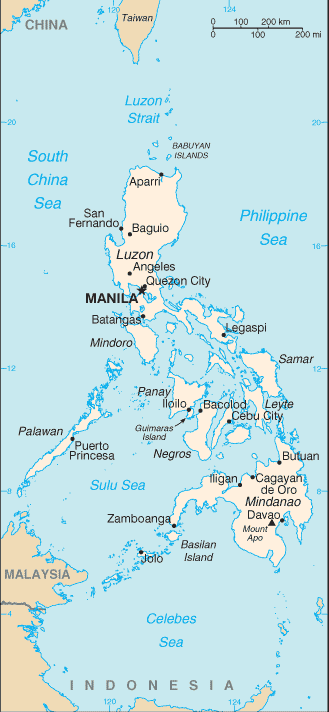|
Philippines
|

|
Capital: Manila
Population: 108,116,615
Brief History of Philippines:
The Philippines was originally settled by a people called the Negritos. They arrived at the islands thousands of years ago. The Polynesians arrived next and the island became populated with tribal peoples led by chieftains called datus. Later in the history of the Philippines, Chinese and Arab traders arrived.
In 1521 the first European to arrive was Ferdinand Magellan from Portugal. He claimed the land for Spain, but was killed on the island when trying to resolve an argument between two local tribes. Spain would colonize the country over the coming years and would rule until the Spanish-American War in 1898 when the United States defeated the Spanish fleet in Manila Bay. That same year revolutionary leader Emilio Aguinaldo declared the Philippines' independence from Spain.
The United States officially gained control of the Philippines following the Spanish-American War and the Treaty of Paris. War broke out between the Philippines and the United States, but soon subsided. In 1935, the US made the Philippines a self-governing territory under President Manuel Quezon. During World War II the Philippines was occupied by Japan. With the help of American forces, the Japanese were driven out. In 1946, the country became a fully independent nation.
The Geography of Philippines
Total Size: 300,000 square km
Size Comparison: slightly larger than Arizona
Geographical Coordinates: 13 00 N, 122 00 E
World Region or Continent: Southeast Asia
General Terrain: mostly mountains with narrow to extensive coastal lowlands
Geographical Low Point: Philippine Sea 0 m
Geographical High Point: Mount Apo 2,954 m
Climate: tropical marine; northeast monsoon (November to April); southwest monsoon (May to October)
Major cities: MANILA (capital) 11.449 million; Davao 1.48 million; Cebu City 845,000; Zamboanga 827,000 (2009)
The People of Philippines
Type of Government: republic
Languages Spoken: two official languages - Filipino (based on Tagalog) and English; eight major dialects - Tagalog, Cebuano, Ilocano, Hiligaynon or Ilonggo, Bicol, Waray, Pampango, and Pangasinan
Independence: 12 June 1898 (from Spain)
National Holiday: Independence Day, 12 June (1898); note - 12 June 1898 was date of declaration of independence from Spain; 4 July 1946 was date of independence from US
Nationality: Filipino(s)
Religions: Roman Catholic 80.9%, Evangelical 2.8%, Iglesia ni Kristo 2.3%, Aglipayan 2%, other Christian 4.5%, Muslim 5%, other 1.8%, unspecified 0.6%, none 0.1% (2000 census)
National Symbol: Philippine eagle
National Anthem or Song: Lupang Hinirang (Chosen Land)
Economy of Philippines
Major Industries: electronics assembly, garments, footwear, pharmaceuticals, chemicals, wood products, food processing, petroleum refining, fishing
Agricultural Products: sugarcane, coconuts, rice, corn, bananas, cassavas, pineapples, mangoes; pork, eggs, beef; fish
Natural Resources: timber, petroleum, nickel, cobalt, silver, gold, salt, copper
Major Exports: electronic equipment, machinery and transport equipment, garments, optical instruments, coconut products, fruits and nuts, copper products, chemicals
Major Imports: raw materials, machinery and equipment, fuels, vehicles and vehicle parts, plastic, chemicals, grains
Currency: Philippine peso (PHP)
National GDP: $391,100,000,000
** Source for population (2012 est.) and GDP (2011 est.) is CIA World Factbook.
Back to Geography Home Page
